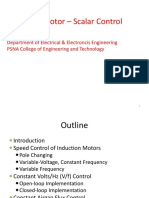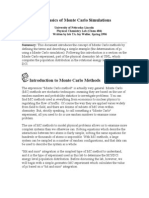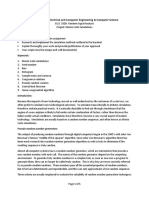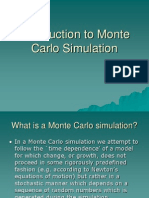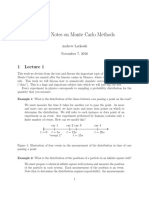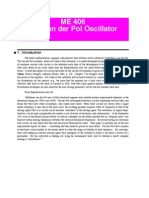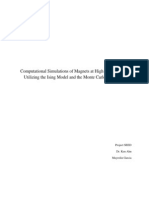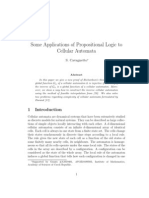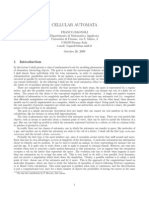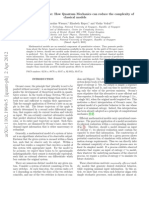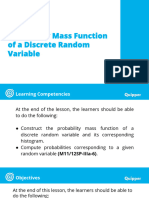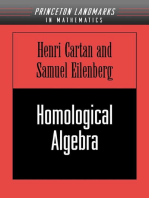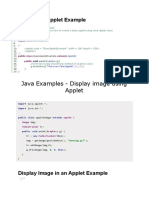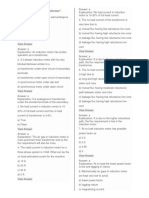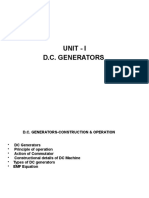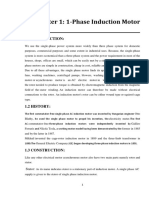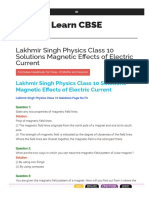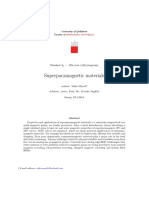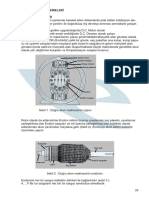100%(1)100% found this document useful (1 vote)
2K viewsMonte Carlo Simulation in Java
Monte Carlo Simulation in Java
Uploaded by
Manoj KavediaMonte Carlo simulation is an analytic method that imitates a physical system by using randomly generated values for uncertain variables. It is named after the famous casino in Monaco. Monte Carlo simulations are widely applicable when other techniques fail due to their computational intensity. They involve repeating a simulation many times to generate a range of possible scenarios and then averaging the results. Accuracy increases with the square root of the number of repetitions. Common applications include designing nuclear reactors, predicting star evolution, and forecasting stock markets.
Copyright:
© All Rights Reserved
Available Formats
Download as DOC, PDF, TXT or read online from Scribd
Monte Carlo Simulation in Java
Monte Carlo Simulation in Java
Uploaded by
Manoj Kavedia100%(1)100% found this document useful (1 vote)
2K views15 pagesMonte Carlo simulation is an analytic method that imitates a physical system by using randomly generated values for uncertain variables. It is named after the famous casino in Monaco. Monte Carlo simulations are widely applicable when other techniques fail due to their computational intensity. They involve repeating a simulation many times to generate a range of possible scenarios and then averaging the results. Accuracy increases with the square root of the number of repetitions. Common applications include designing nuclear reactors, predicting star evolution, and forecasting stock markets.
Original Description:
Monte Carlo Simulation in Java
Copyright
© © All Rights Reserved
Available Formats
DOC, PDF, TXT or read online from Scribd
Share this document
Did you find this document useful?
Is this content inappropriate?
Monte Carlo simulation is an analytic method that imitates a physical system by using randomly generated values for uncertain variables. It is named after the famous casino in Monaco. Monte Carlo simulations are widely applicable when other techniques fail due to their computational intensity. They involve repeating a simulation many times to generate a range of possible scenarios and then averaging the results. Accuracy increases with the square root of the number of repetitions. Common applications include designing nuclear reactors, predicting star evolution, and forecasting stock markets.
Copyright:
© All Rights Reserved
Available Formats
Download as DOC, PDF, TXT or read online from Scribd
Download as doc, pdf, or txt
100%(1)100% found this document useful (1 vote)
2K views15 pagesMonte Carlo Simulation in Java
Monte Carlo Simulation in Java
Uploaded by
Manoj KavediaMonte Carlo simulation is an analytic method that imitates a physical system by using randomly generated values for uncertain variables. It is named after the famous casino in Monaco. Monte Carlo simulations are widely applicable when other techniques fail due to their computational intensity. They involve repeating a simulation many times to generate a range of possible scenarios and then averaging the results. Accuracy increases with the square root of the number of repetitions. Common applications include designing nuclear reactors, predicting star evolution, and forecasting stock markets.
Copyright:
© All Rights Reserved
Available Formats
Download as DOC, PDF, TXT or read online from Scribd
Download as doc, pdf, or txt
You are on page 1of 15
Monte carlo Simulation in java
This section under major construction.
In 1953 Enrico Fermi, John Pasta, and Stanslaw Ulam created the frst "computer
experiment" to study a vibrarting atomic lattice. Nonlinear system couldn't be
analyzed by classical mathematics.
Simulation = analytic method that imitates a physical system. Monte Carlo simulation
= use randomly generated values for uncertain variables. Named after famous
casino in Monaco. At essentially each step in the evolution of the calculation, Repeat
several times to generate range of possible scenarios, and average results. Widely
applicable brute force solution. Computationally intensive, so use when other
techniques fail. Typically, accuracy is proportional to square root of number of
repetitions. Such techniques are widely applied in various domains including:
designing nuclear reactors, predicting the evolution of stars, forecasting the stock
market, etc.
Generating random numbers. The math library function Math.random generate a
pseudo-random number greater than or equal to 0.0 and less than 1.0. If you want to
generate random integers or booleans, the best way is to use the library Random.
Program RandomDemo.java illustrates how to use it.
Random random = new Random();
boolean a = random.nextBoolean(); // true or false
int b = random.nextInt(); // between -2^! and 2^! - !
int " = random.nextInt(!##); // between # and $$
double d = random.next%ouble(); // between #.# and !.#
double e = random.next&aussian(); // &aussian with mean # and stdde' =
!
Note that you should only create a new Random object once per program. You will not
get more "random" results by creating more than one. For debugging, you may wish
to produce the same sequence of pseudo-random number each time your program
executes. To do this, invoke the constructor with a lon( argument.
Random random = new Random(!2)*+,-);
The pseudo-random number generator will use 1234567 as the seed.
Use .e"ureRandom for cryptographically secure pseudo-random numbers, e.g., for
cryptography or slot machines.
Linear congruential random number generator. With integer types we must be
cognizant of overfow. Consider a * b (mod m) as an example (either in context of a^b
(mod m) or linear congruential random number generator: Given constants a, c, m,
and a seed x[0], iterate: x = (a * x + c) mod m. Park and Miller suggest a = 16807, m
= 2147483647, c = 0 for 32-bit signed integers. To avoid overfow, use Schrage's
method.
/re"om0ute1 2 = m / a3 r = m 4 a
Iterate1 x = a 5 (x - x/ 2) 5 2) - r 5 (x / 2)
Exercise: compute cycle length.
Library of probability functions. OR-Objects contains many classic probability
distributions and random number generators, including Normal, F, Chi Square,
Gamma, Binomial, Poisson. You can download the jar fle here.
Program ProbDemo.java illustrates how to use it. It generate one random value from
the gamma distribution and 5 from the binomial distribution. Note that the method is
called (etRandom."aler and not(etRandom."alar.
&amma%istribution x = new &amma%istribution(23 );
.6stem.out.0rintln(x.(etRandom."aler());
Binomial%istribution 6 = new Binomial%istribution(#.!3 !##);
.6stem.out.0rintln(6.(etRandom7e"tor(*));
Queuing models. M/M/1, etc. A manufacturing facility has M identical machines.
Each machine fails after a time that is exponentially distributed with mean 1 / . A
single repair person is responsible for maintaining all the machines, and the time to
fx a machine is exponentially distributed with mean 1 / . Simulate the fraction of
time in which no machines are operational.
Difusion-limited aggregation.
Difuse = undergo random walk. The physical process difusion-limited
aggregation (DLA) models the formation of an aggregate on a surface, including
lichen growth, the generation of polymers out of solutions, carbon deposits on the
walls of a cylinder of a Diesel engine, path of electric discharge, and urban
settlement.
The modeled aggregate forms when particles are released one at a time into a
volume of space and, infuenced by random thermal motion, they difuse throughout
the volume. There is a fnite probability that the short-range attraction between
particles will infuence the motion. Two particles which come into contact with each
other will stick together and form a larger unit. The probability of sticking increases
as clusters of occupied sites form in the aggregate, stimulating further growth.
Simulate this process in 2D using Monte Carlo methods: Create a 2D grid and
introduce particles to the lattice through a launching zone one at a time. After a
particle is launched, it wanders throughout with a random walk until it either sticks to
the aggregate or wanders of the lattice into the kill zone. If a wandering particle
enters an empty site next to an occupied site, then the particle's current location
automatically becomes part of the aggregate. Otherwise, the random walk continues.
Repeat this process until the aggregate contains some pre-determined number of
particles. Reference: Wong, Samuel, Computational Methods in Physics and
Engineering, 1992.
Program DLA.java simulates the growth of a DLA with the following properties. It
uses the helper data type Picture.java. Set the initial aggregate to be the bottom row
of the N-by-N lattice. Launch the particles from a random cell in top row. Assume that
the particle goes up with probability 0.15, down with probability 0.35, and left or right
with probability 1/4 each. Continue until the particles stick to a neighboring cell
(above, below, left, right, or one of the four diagonals) or leaves the N-by-N lattice.
The preferred downward direction is analogous to the efect of a temperature
gradient on Brownian motion, or like how when a crystal is formed, the bottom of the
aggregate is cooled more than the top; or like the infuence of a gravitational force.
For efect, we color the particles in the order they are released according to the
rainbow from red to violet. Below are three simulations with N = 176; here is an
image with N = 600.
Brownian motion. Brownian motion is a random process used to model a wide
variety of physical phenomenon including the dispersion of ink fowing in water, and
the behavior of atomic particles predicted by quantum physics. (more applications).
Fundamental random process in the universe. It is the limit of a discrete random walk
and the stochastic analog of the Gaussian distribution. It is now widely used in
computational fnance, economics, queuing theory, engineering, robotics, medical
imaging, biology, and fexible manufacturing systems. First studied by a Scottish
botanist Robert Brown in 1828 and analyzed mathematically by Albert Einstein in
1905. Jean-Baptiste Perrin performed experiments to confrm Einstein's predictions
and won a Nobel Prize for his work. An applet to illustrate physical process that may
govern cause of Brownian motion.
Simulating a Brownian motion. Since Brownian motion is a continuous and
stochastic process, we can only hope to plot one path on a fnite interval, sampled at
a fnite number of points. We can interpolate linearly between these points (i.e.,
connect the dots). For simplicitly, we'll assume the interval is from 0 to 1 and the
sample points t
0
, t
1
, ..., t
N
are equally spaced in this interval. To simulate a standard
Brownian motion, repeatedly generate independent Gaussian random variables with
mean 0 and standard deviation sqrt(1/N). The value of the Brownian motion at time i
is the sum of the frst i increments.
Geometric Brownian motion. A variant of Brownian motion is widely used to model
stock prices, and the Nobel-prize winning Black-Scholes model is centered on this
stochastic process. A geometric Brownian motion with drift and volatility is a
stochastic process that can model the price of a stock. The parameter models the
percentage drift. If = 0.10, then we expect the stock to increase by 10% each year.
The parameter models the percentage volatility. If = 0.20, then the standard
deviation of the stock price over one year is roughly 20% of the current stock price.
To simulate a geometric Brownian motion from time t = 0 to t = T, we follow the same
procedure for standard Brownian motion, but multiply the increments, instead of
adding them, and incorporate the drift and volatility parameters. Specifcally, we
multiply the current price by by (1 + t + sqrt(t)Z), where Z is a standard
Gaussian and t = T/N Start with X(0) = 100, = 0.04.
construction of BM.
Black-Scholes formula. Move to here?
Ising model. The motions of electrons around a nucleus produce a magnetic feld
associated with the atom. These atomic magnets act much like conventional
magnets. Typically, the magnets point in random directions, and all of the forces
cancel out leaving no overall magnetic feld in a macroscopic clump of matter.
However, in some materials (e.g., iron), the magnets can line up producing a
measurable magnetic feld. A major achievement of 19th century physics was to
describe and understand the equations governing atomic magnets. The probability
that state S occurs is given by the Boltzmann probability density function P(S) = e
-
E(S)/kT
/ Z, where Z is the normalizing constant (partition function) sum e
-E(A)/kT
over all
states A, k is Boltzmann's constant, T is the absolute temperature (in degrees
Kelvin), and E(S) is the energy of the system in state S.
Ising model proposed to describe magnetism in crystalline materials. Also models
other naturally occurring phenomena including: freezing and evaporation of liquids,
protein folding, and behavior of glassy substances.
Ising model. The Boltzmann probability function is an elegant model of magnetism.
However, it is not practical to apply it for calculating the magnetic properties of a real
iron magnet because any macroscopic chunk of iron contains an enormous number
atoms and they interact in complicated ways. The Ising model is a simplifed model
for magnets that captures many of their important properties, including phase
transitions at a critical temperature. (Above this temperature, no macroscopic
magnetism, below it, systems exhibits magnetism. For example, iron loses its
magnetization around 770 degrees Celsius. Remarkable thing is that transition is
sudden.) reference
First introduced by Lenz and Ising in the 1920s. In the Ising model, the iron magnet
is divided into an N-by-N grid of cells. (Vertex = atom in crystal, edge = bond
between adjacent atoms.) Each cell contains an abstract entity known as spin. The
spin s
i
of cell i is in one of two states: pointing up (+1) or pointing down (-1). The
interactions between cells is limited to nearest neighbors. The total magnetism of the
system M = sum of s
i
. The total energy of the system E = sum of - J s
i
s
j
, where the
sum is taken over all nearest neighbors i and j. The constant J measures the
strength of the spin-spin interactions (in units of energy, say ergs). [The model can
be extended to allow interaction with an external magnetic feld, in which case we
add the term -B sum of s
k
over all sites k.] If J > 0, the energy is minimized when the
spins are aligned (both +1 or both -1) - this modelsferromagnetism. if J < 0, the
energy is minimized when the spins are oppositely aligned - this
models antiferromagnetism.
Given this model, a classic problem in statistical mechanics is to compute the
expected magenetism. A state is the specifcation of the spin for each of the N^2
lattice cells. The expected magnetism of the system E[M] = sum of M(S) P(S) over all
states S, where M(S) is the magnetism of state S, and P(S) is the probability of state
S occurring according to the Boltzmann probability function. Unfortunately, this
equation is not amenable to a direct computational because the number of states S
is 2
N*N
for an N-by-N lattice. Straightforward Monte Carlo integration won't work
because random points will not contribute much to sum. Need selective sampling,
ideally sample points proportional to e
-E/kT
. (In 1925, Ising solved the problem in one
dimension - no phase transition. In a 1944 tour de force, Onsager solved the 2D
Ising problem exactly. His solution showed that it has a phase transition. Not likely to
be solved in 3D - see intractability section.)
Metropolis algorithm. Widespread usage of Monte Carlo methods began with
Metropolis algorithm for calculation of rigid-sphere system. Published in 1953 after
dinner conversation between Metropolis, Rosenbluth, Rosenbluth, Teller, and Teller.
Widely used to study equilibrium properties of a system of atoms. Sample using
Markov chain using Metropolis' rule: transition from A to B with probability 1 if E <=
0, and with probability e
-E/kT
if E > 0. When applied to the Ising model, this Markov
chain is ergodic (similar to Google PageRank requirement) so the theory underlying
the Metropolis algorithm applies. Converges to stationary distribution.
Program Cell.java, State.java, and Metropolis.java implements the Metropolis
algorithm for a 2D lattice. Ising.java is a procedural programming version. "Doing
physics by tossing dice." Simulate complicated physical system by a sequence of
simple random steps.
Measuring physical quantities. Measure magnetism, energy, specifc heat when
system has thermalized (the system has reached a thermal equilibrium with its
surrounding environment at a common temperature T). Compute the average
energy and the average magenetization over time. Also interesting to compute the
variance of the energy or specifc heat <c> = <E
2
> - <E>
2
, and the variance of the
magnetization or susceptibility<> = <M
2
> - <M>
2
. Determining when system has
thermalized is a challenging problem - in practice, many scientists use ad hoc
methods.
Phase transition. Phase transition occurs when temperature T
c
is 2 / ln(1 + sqrt(2)) =
2.26918). T
c
is known as the Curie temperature. Plot magnetization M (average of all
spins) vs. temperature (kT = 1 to 4). Discontinuity of slope is signature of second
order phase transition. Slope approaches infnity. Plot energy (average of all spin-
spin interactions) vs. temperature (kT = 1 to 4). Smooth curve through phase
transition. Compare against exact solution. Critical temperature for which algorithm
dramatically slows down. Below are the 5000th sample trajectory for J/kT = 0.4 (hot /
disorder) and 0.47 (cold / order). The system becomes magnetic as temperature
decreases; moreover, as temperature decreases the probability that neighboring
sites have the same spin increasing (more clumping).
Experiments.
Start will above critical temperature. State converges to nearly uniform
regardless of initial state (all up, all down, random) and fuctuates rapidly.
Zero magnetization.
Start well below critical temperature. Start all spins with equal value (all up or
all down). A few small clusters of opposite spin form.
Start well below critical temperature. Start with random spins. Large clusters
of each spin form; eventually simulation makes up its mind. Equally likely to
have large clusters in up or down spin.
Start close to critical temperature. Large clusters form, but fuctuate very
slowly.
Exact solution for Ising model known for 1D and 2D; NP-hard for 3d and nonplanar
graphs.
Models phase changes in binary alloys and spin glasses. Also models neural
networks, focking birds, and beating heart cells. Over 10,000+ papers published
using the Ising model.
Java Simulation --- Calculate PI using Random Numbers
import java.util.*;
public class CalculatePI2
{
public static boolean isInside (double xPos, double Pos!
{
boolean result;
double distance " Mat#.s$rt((xPos * xPos! % (Pos * Pos!!;
i& (distance ' (!
result " &alse;
return(distance ' (!;
)
public static double computePI (int num*#ro+s!
{
,andom random-en " ne+ ,andom (Sstem.current*imeMillis(!!;
int #its " .;
double PI " .;
&or (int i " .; i '" num*#ro+s; i%%!
{
double xPos " (random-en.next/ouble(!! * 2 0 (..;
double Pos " (random-en.next/ouble(!! * 2 0 (..;
i& (isInside(xPos, Pos!!
{
#its%%;
)
PI " (1 * (#its2num*#ro+s!!;
)
return PI;
)
public static void main (Strin345 ar3s!
{
Scanner reader " ne+ Scanner (Sstem.in!;
Sstem.out.println(6*#is pro3ram approximates PI usin3 t#e Monte Carlo
met#od.6!;
Sstem.out.println(6It simulates t#ro+in3 darts at a dartboard.6!;
Sstem.out.print(6Please enter number o& t#ro+s7 6!;
int num*#ro+s " reader.nextInt(!;
double PI " computePI(num*#ro+s!;
double /i&&erence " PI 0 Mat#.PI;
Sstem.out.println (68umber o& t#ro+s " 6 % num*#ro+s % 6, Computed
PI " 6 % PI % 6, /i&&erence " 6 % /i&&erence !;
)
)
Introduction
A class of computational algorithms that rely on repeated random sampling to
compute their results are called the Monte Carlo methods. Monte Carlo methods
are often used when simulating physical and mathematical systems. Because of
their reliance on repeated computation and random or pseudo-random numbers,
Monte Carlo methods are most suited to calculation by a computer. Monte Carlo
methods tend to be used when it is infeasible or impossible to compute an exact
result with a deterministic algorithm.
Monte Carlo algorithms work based on the aw of arge !umbers. It says that if
you generate a large number of samples, e"entually, you will get the
approximate desired distribution.
Monte Carlo methods ha"e three characteristics#
$. %andom sample generation
&. 'he input distribution is known
(. !umerical experiments
'he direct output of the Monte Carlo simulation method is the generation of
random sampling. )ther performance or statistical outputs are indirect methods
which depend on the applications.
'here are many di*erent numerical experiments that can be done, probability
distribution is one of them.
+robability distribution identi,es either the probability of each "alue of an
unidenti,ed random "ariable -when the "ariable is discrete., or the probability of
the "alue falling within a particular inter"al -when the "ariable is continuous..
'hat is e/ui"alent to saying that for random "ariables 0 with the distribution in
/uestion, +r10 2 a3 2 4 for all real numbers a. 'hat is, the probability that 0
attains the "alue a is 5ero, for any number a. If the distribution of 0 is continuous,
then 0 is called a continuous random "ariable.
!ormal distribution, continuous uniform distribution, beta distribution, and
6amma distribution are well known absolutely continuous distributions.
In the sample program, I will be using a 'riangular distribution, which is is a
continuous probability distribution with a lower limit a, mode c, and upper limit b.
'riangular distribution is therefore often used in business decision making,
particularly in simulations. 6enerally, when not much is known about the
distribution of an outcome -say, only its smallest and largest "alues., it is
possible to use uniform distribution. But, if the most likely outcome is also known,
then the outcome can be simulated by a 'riangular distribution.
7hilst Monte Carlo methods can be a "aluable aid to decision making, they
should not be used without an understanding of the process being modeled.
'ypically, in any acti"ity, there are a few critical inputs, and it is these which
should be the focus of the analysis, not trying to attribute complex distributions
to minor "ariables. 8o, a Monte Carlo analysis should be preceded by a sensiti"ity
analysis to determine what the important parameters are.
Background
'here are many ways of approaching a Monte Carlo analysis, but a good starting
point is a 9ow chart of the processing being modeled.
:or the purposes of this simulation, I will be focus on a tennis tournament
simulation based on game winnings.
'he 9ow chart of the process goes like this#
;sing the code
<ere is an example where we ha"e two players, each with "arying skills and
talent. Assume they each ha"e played $4 tournaments and we ha"e gotten the
minimum and maximum number of wins -assuming winning the tournament has
the same number of wins as all the other tournaments.. 7e can also compute the
mean win for all the $4 tournaments they ha"e played.
Collapse = Copy Code
double13 >ar7ins 2 new double13?player$,player&@3A
double13 min7ins 2 new double13?$$,$&@A
double13 mean7ins 2 new double13?$&.B,$(@A
double13 max7ins 2 new double13?$C,$B@A
double13 results 2 MonteCarlo.simulate-&, new double13 ? $$, $& @,
new double13 ? $&.B, $( @, new double13 ? $C, $B @.A
'he main simulation is done using the following triangular distribution#
Collapse = Copy Code
public static double triangular-double Min,double Mode,double Max.
?
// Declarations
double %24.4A
// Initialise
%andom r 2 new %andom-.A
% 2 r.!extDouble-.A //between 0.0 and 1.0 gaussian
// Triangular
if - % 22 -- Mode - Min. E - Max - Min...
?
return ModeA
@
else if - % F -- Mode - Min. E - Max - Min...
?
return Min G Math.8/rt- % H - Max - Min. H - Mode - Min..A
else
?
return Max - Math.8/rt--$ - %. H - Max - Min. H - Max - Mode..A
@
@
As seen in the output, player $ is the most likely to win. <owe"er, player & is not
far behind. 8o, with a little more practice and training, player & manages to
reduce the mean number of wins on the next $4 tournaments. 8imulating this
again will show that he has greatly impro"ed his performance and is most likely
to win o"er player $.
)utput#
Collapse = Copy Code
8imulation %esults
7insB&B$
7insICIJ
+layer$ win probability B&.B$
- +layer& win probabilityIC.IJ
)utput after training#
Collapse = Copy Code
8imulation %esults
7insI$$J
7insBKK$
+layer$ win probability I$.$J
- +layer& win probabilityBK.K$#
'here are some instances where it is the other way around. As I ha"e mentioned
ealier, by the aw of arge !umbers, if you increase the number of simulated
tournaments, you will notice that either player will always be the winner because
the expected result will always come closer because of the large number of
simulations.
More examples on the Monte Carlo algorithm can be found here.
Application
Monte Carlo methods are often used in +hysics to determine neutron traLectories
or to simulate atomic clusters. In the $JB4s, Monte Carlo methods were used to
study nuclear cascades. 7hen a particle collides with a nucleus, a nuclear
cascade is produced.
'he particleMs path after the collision determines whether or not a new particle, a
pion, is created. Monte Carlo methods keep track of the colliding particleMs path
after the collision and determine the probability of the production of pions. Monte
Carlo algorithms are useful here because it is diNcult and time-consuming to
simulate the collisions. By running the algorithm enough times, the results are
usually statistically signi,cant, and we are able to successfully calculate the
probability of the production of nuclear cascades. Chemistry is another ,eld
where Monte Carlo methods come in handy.
Monte Carlo methods are often used to e"aluate integrals. 7hile integrals can be
e"aluated by many other mathematical methods, it is, sometimes too complex
for other methods to e"aluate an integral as its dimensionality grows. !ot being
able to e"aluate an integral with growing dimensions is known as the Ocurse of
dimensionalityM. <owe"er, Monte Carlo methods outdo this curse because they
work increasingly better with more complex integrals that contain high
dimensions. P"aluation of multidimensional integrals is useful in calculating the
"olume of molecules. 8ince molecules do not ha"e de,ned boundaries, "olume
calculations in"ol"e multidimensional integration. It is diNcult to calculate the
"olume without the use of Monte Carlo methods because of the complexity
in"ol"ed and also because de,nite boundaries of the molecules are unde,ned.
>olumes of molecules are often de,ned by a range of electron densities, so
Monte Carlo methods use random number generation and a probability
distribution function to e"aluate the "olumes of molecules.
)ne of the most popular applications of the Monte Carlo algorithms is in the ,eld
of ,nance. Monte Carlo methods aid the analysis of ,nancial instruments,
portfolios, and assets. 7hen a ,nancial instrument or asset is being analy5ed to
label its "alue, many complex e/uations, the "alues of which may be uncertain,
are used to reach a ,nal answer. 8ince Monte Carlo methods work well with
highly complex e/uations, their use becomes "ital in the calculation of uncertain
"alues, which then in turn help analy5e the ,nal "alue of the instrument or asset
in /uestion. A speci,c OMonte Carlo )ption ModelM is used to e"aluate future
prices of options. Many uncertain "alues a*ect the ,nal "alue of these ,nancial
optionsA Monte Carlo methods use random number generation to lay the "arious
price paths and then calculate a ,nal option "alue.
2* Code is in Monte Carlo.9ip *2
You might also like
- 600 Watt, 3d-Printed, Halbach Array, Brushless Motor - ProjectsDocument13 pages600 Watt, 3d-Printed, Halbach Array, Brushless Motor - ProjectsGianlucaD'Andrea100% (1)
- Salinas SolutionDocument40 pagesSalinas SolutionRodolfo AraújoNo ratings yet
- Monte Carlo Simulations With Implementations in MATLABDocument10 pagesMonte Carlo Simulations With Implementations in MATLABCarlos Moscoso AllelNo ratings yet
- Induction Motor Speed ControlDocument46 pagesInduction Motor Speed ControlakhilNo ratings yet
- Compass ErrorDocument9 pagesCompass ErrorIonut Neamtu100% (4)
- The Basics of Monte Carlo SimulationsDocument5 pagesThe Basics of Monte Carlo SimulationsAmanjeet KaurNo ratings yet
- Random Project 222Document5 pagesRandom Project 222crkriskyNo ratings yet
- PHY 331 Practical 3 - The Random Walk in Two DimensionsDocument4 pagesPHY 331 Practical 3 - The Random Walk in Two DimensionsgogogoreaperNo ratings yet
- MOnte Carlo SimulationDocument19 pagesMOnte Carlo SimulationRatish MayankNo ratings yet
- Lecture Notes On Monte Carlo Methods: Andrew Larkoski November 7, 2016Document19 pagesLecture Notes On Monte Carlo Methods: Andrew Larkoski November 7, 2016Shiraz SiddiquiNo ratings yet
- BF 01022990Document78 pagesBF 01022990Pranav ParakhNo ratings yet
- Report On Nonlinear DynamicsDocument24 pagesReport On Nonlinear DynamicsViraj NadkarniNo ratings yet
- Monte Carlo 1Document17 pagesMonte Carlo 1Asim HashmiNo ratings yet
- ME 406 The Van Der Pol Oscillator: 1. IntroductionDocument15 pagesME 406 The Van Der Pol Oscillator: 1. IntroductionIsuck91No ratings yet
- Unit 1 Continue, Unit 2 & Unit 5Document75 pagesUnit 1 Continue, Unit 2 & Unit 5projectemailid1No ratings yet
- Applied Satistical Mechanics PBL ReportDocument23 pagesApplied Satistical Mechanics PBL ReportShubham RawatNo ratings yet
- Computational Science For Engineers - Unit-IV - DataDrivenModels - Simulations, Random Numbers and Random WalkDocument31 pagesComputational Science For Engineers - Unit-IV - DataDrivenModels - Simulations, Random Numbers and Random Walkrt.cseNo ratings yet
- Monte Carlo - SubhadipDocument34 pagesMonte Carlo - SubhadipIndra Prakash JhaNo ratings yet
- Introduction To Monte Carlo Methods: Daan FrenkelDocument34 pagesIntroduction To Monte Carlo Methods: Daan FrenkeljimusosNo ratings yet
- Mayrolin Garcia ReportDocument19 pagesMayrolin Garcia Reportakhilesh_353859963No ratings yet
- Computer Modelling Using FORTRANDocument12 pagesComputer Modelling Using FORTRANNeerajNo ratings yet
- Biological ColisionDocument4 pagesBiological ColisionDemian PereiraNo ratings yet
- Sequence Space JacobianDocument84 pagesSequence Space JacobianStan ChrisinskyNo ratings yet
- Applications of Propositional Logic To Cellular AutomataDocument25 pagesApplications of Propositional Logic To Cellular AutomatastefanodotNo ratings yet
- Entropy and Perpetual Computers: Institute of Physics, Bhubaneswar 751 005, India Email: Somen@iopb - Res.inDocument9 pagesEntropy and Perpetual Computers: Institute of Physics, Bhubaneswar 751 005, India Email: Somen@iopb - Res.inAvinanda ChaudhuriNo ratings yet
- SchrödingerDocument18 pagesSchrödingerviskaNo ratings yet
- Algorithmic Randomness and Complexity: Rod Downey Victoria University Wellington New ZealandDocument46 pagesAlgorithmic Randomness and Complexity: Rod Downey Victoria University Wellington New Zealand3dman3dNo ratings yet
- Introduction To MATLAB 3rd Ed Etter ProblemsDocument11 pagesIntroduction To MATLAB 3rd Ed Etter ProblemsAndy OcegueraNo ratings yet
- Unit V Graphical ModelsDocument23 pagesUnit V Graphical ModelsIndumathy ParanthamanNo ratings yet
- Nbs VonneumannDocument3 pagesNbs VonneumannRishav DhungelNo ratings yet
- Chap. 49 Modes: 3. Modes On Regular Triangular DrumDocument9 pagesChap. 49 Modes: 3. Modes On Regular Triangular DrumfudogNo ratings yet
- 3.1 Basics of Pseudo-Random Numbers GeneratorsDocument10 pages3.1 Basics of Pseudo-Random Numbers GeneratorsEduardo LópezNo ratings yet
- 3.1 Basics of Pseudo-Random Numbers GeneratorsDocument10 pages3.1 Basics of Pseudo-Random Numbers GeneratorsMustafa RaadNo ratings yet
- Monte Carlo Methods PDFDocument6 pagesMonte Carlo Methods PDFbhuniakanishkaNo ratings yet
- A5: Problem On Kinetic Monte Carlo and Molecular DynamicsDocument2 pagesA5: Problem On Kinetic Monte Carlo and Molecular DynamicsRohitThakranNo ratings yet
- Unit V Questions and Answers 30-03-2023Document4 pagesUnit V Questions and Answers 30-03-2023Anirudha KrishnaNo ratings yet
- Problem Set 3Document15 pagesProblem Set 3George MSenoirNo ratings yet
- ME SP 11 Q3 0201 PSDocument27 pagesME SP 11 Q3 0201 PStintincabos09No ratings yet
- Problem 17:: Solutions For Class #13 From Yosumism WebsiteDocument10 pagesProblem 17:: Solutions For Class #13 From Yosumism WebsiteTom JonesNo ratings yet
- Monte Carlo PIDocument2 pagesMonte Carlo PIadityabpatelNo ratings yet
- Cellular AutomataDocument26 pagesCellular AutomataHenrique Fabricio GagliardiNo ratings yet
- Random Montecarlo 2005Document46 pagesRandom Montecarlo 2005Anupama KuNo ratings yet
- Particle Transport: Monte Carlo Methods Versus Moment EquationsDocument16 pagesParticle Transport: Monte Carlo Methods Versus Moment EquationsfieldpNo ratings yet
- CN Project IIDocument6 pagesCN Project IIVikram MohantyNo ratings yet
- Occam's Quantum Razor: How Quantum Mechanics Can Reduce The Complexity of Classical ModelsDocument6 pagesOccam's Quantum Razor: How Quantum Mechanics Can Reduce The Complexity of Classical ModelsDavid ZuecoNo ratings yet
- 1 Computer Lab For Astrophysical Gasdynamics Course (Mellema 2011)Document9 pages1 Computer Lab For Astrophysical Gasdynamics Course (Mellema 2011)LurzizareNo ratings yet
- Probability Mass Function of A Discrete Random VariableDocument32 pagesProbability Mass Function of A Discrete Random Variablesingaporedelacruz20No ratings yet
- Introduction To ProbabilityDocument510 pagesIntroduction To Probabilitymiss_bnmNo ratings yet
- The Approach To Equilibrium: Project PHYSNET Physics Bldg. Michigan State University East Lansing, MIDocument8 pagesThe Approach To Equilibrium: Project PHYSNET Physics Bldg. Michigan State University East Lansing, MIEpic WinNo ratings yet
- 15 Monte Carlo Simulation MethodDocument11 pages15 Monte Carlo Simulation MethodrogeriojuruaiaNo ratings yet
- Part 4 Diffusion and HopsDocument24 pagesPart 4 Diffusion and HopsOmegaUserNo ratings yet
- Chaos and Its Computing Paradigm: Dwight KuoDocument3 pagesChaos and Its Computing Paradigm: Dwight KuoRicku LpNo ratings yet
- Krauth W. Introduction To Monte-Carlo Algorithms (Cond-Mat 9612186, 1996) (43s) MNsDocument43 pagesKrauth W. Introduction To Monte-Carlo Algorithms (Cond-Mat 9612186, 1996) (43s) MNsSrinivasaNo ratings yet
- Monte Carlo Experiments: Version: 4-10-2010, 20:37Document6 pagesMonte Carlo Experiments: Version: 4-10-2010, 20:37Mian AlmasNo ratings yet
- Monte Carlo SimulationDocument4 pagesMonte Carlo SimulationVictor AnayaNo ratings yet
- Lecture 6: Random WalksDocument20 pagesLecture 6: Random WalksSigit KurniawanNo ratings yet
- On The Markov Chain Monte Carlo (MCMC) Method: Rajeeva L KarandikarDocument24 pagesOn The Markov Chain Monte Carlo (MCMC) Method: Rajeeva L KarandikarDiana DilipNo ratings yet
- Stationary and Related Stochastic Processes: Sample Function Properties and Their ApplicationsFrom EverandStationary and Related Stochastic Processes: Sample Function Properties and Their ApplicationsRating: 4 out of 5 stars4/5 (2)
- Arduino - Basic ProgrammingDocument47 pagesArduino - Basic ProgrammingManoj KavediaNo ratings yet
- Establishing JDBC Connection in JavaDocument39 pagesEstablishing JDBC Connection in JavaManoj KavediaNo ratings yet
- Experiment No 9 Calculations On Memory LocationsDocument2 pagesExperiment No 9 Calculations On Memory LocationsManoj KavediaNo ratings yet
- 22-03-2017 Ste PSTDocument5 pages22-03-2017 Ste PSTManoj KavediaNo ratings yet
- Machine, Domain Specific - Automotive. Peripherals, Memory - RAM, ROM, Types of RAM and ROM, Memory Testing, CRC, Flash MemoryDocument2 pagesMachine, Domain Specific - Automotive. Peripherals, Memory - RAM, ROM, Types of RAM and ROM, Memory Testing, CRC, Flash MemoryManoj KavediaNo ratings yet
- Appendix A - Unit Test - 1 Sample PaperDocument13 pagesAppendix A - Unit Test - 1 Sample PaperManoj KavediaNo ratings yet
- Double-Sideband Suppressed Carrier Modulation (DSB-SC) : T A T A T M T C T SDocument28 pagesDouble-Sideband Suppressed Carrier Modulation (DSB-SC) : T A T A T M T C T SManoj KavediaNo ratings yet
- Chapter Wise Question BankDocument15 pagesChapter Wise Question BankManoj KavediaNo ratings yet
- String InstructionsDocument7 pagesString InstructionsManoj Kavedia100% (1)
- Simple Calculator Using AppletDocument6 pagesSimple Calculator Using AppletManoj Kavedia50% (2)
- The 8051 Microcontrollers: Microcontrollers and Embedded Processors, Overview of 8051Document1 pageThe 8051 Microcontrollers: Microcontrollers and Embedded Processors, Overview of 8051Manoj KavediaNo ratings yet
- Appl ItudeDocument73 pagesAppl ItudeManoj KavediaNo ratings yet
- Electronic CircuitsDocument3 pagesElectronic CircuitsManoj KavediaNo ratings yet
- Peltier Effect Based Solar Powered Air Conditioning SystemDocument6 pagesPeltier Effect Based Solar Powered Air Conditioning SystemManoj Kavedia100% (1)
- Applet ExamplesDocument34 pagesApplet ExamplesManoj KavediaNo ratings yet
- Applet ExamplesDocument34 pagesApplet ExamplesManoj KavediaNo ratings yet
- Street Lighting Technology ComparisonDocument7 pagesStreet Lighting Technology ComparisonManoj KavediaNo ratings yet
- Integrator and DifferentiatorDocument7 pagesIntegrator and DifferentiatorManoj Kavedia100% (1)
- Junior College Aided UnaidedDocument40 pagesJunior College Aided UnaidedManoj KavediaNo ratings yet
- Design and Development of Floor Cleaner Robot (Automatic and Manual)Document7 pagesDesign and Development of Floor Cleaner Robot (Automatic and Manual)Manoj KavediaNo ratings yet
- Exception Handling 1Document32 pagesException Handling 1Manoj KavediaNo ratings yet
- Sanfoundry Induction MotorsDocument53 pagesSanfoundry Induction MotorsHazel Grace del MonteNo ratings yet
- List No: Nishishiba Electric Co., LTDDocument17 pagesList No: Nishishiba Electric Co., LTDBorys100% (1)
- EE402 SEM Module 1 PMDC&BLDCDocument41 pagesEE402 SEM Module 1 PMDC&BLDCJohn JNo ratings yet
- Magnetism: Which Diagram Best Shows The Pattern of Field Lines Around A Bar Magnet?Document22 pagesMagnetism: Which Diagram Best Shows The Pattern of Field Lines Around A Bar Magnet?Edgardo Leysa100% (2)
- QUESTIONNAIREDocument5 pagesQUESTIONNAIRERejaNo ratings yet
- Stepper MotorsDocument12 pagesStepper MotorsOlkan Ilter TaşNo ratings yet
- Chapter 3-2d-3d-nmrDocument104 pagesChapter 3-2d-3d-nmrMELVINDO JACOBNo ratings yet
- Article Careers360 20241103105537Document8 pagesArticle Careers360 20241103105537chaasreeNo ratings yet
- DC GeneratorDocument38 pagesDC Generatoraswardi8756No ratings yet
- Introduction To Magnetic Bearings Overview of The PresentationDocument21 pagesIntroduction To Magnetic Bearings Overview of The PresentationAbhijeeth NagarajNo ratings yet
- Chapter 1: 1-Phase Induction Motor: StatorDocument35 pagesChapter 1: 1-Phase Induction Motor: StatorKhushboo SharmaNo ratings yet
- PI734DDocument8 pagesPI734Deng_hopa100% (1)
- Three Phase Induction Motor: Unit 4Document39 pagesThree Phase Induction Motor: Unit 4Hill HermitNo ratings yet
- 19.Moving Charges and MagnetismDocument38 pages19.Moving Charges and Magnetismwww.valerie.snehaNo ratings yet
- How To Calculate Voltage Regulation of Distribution LineDocument5 pagesHow To Calculate Voltage Regulation of Distribution LinewaseemNo ratings yet
- PMSM Parameter Identification For Load Characteristic CalculationDocument10 pagesPMSM Parameter Identification For Load Characteristic CalculationsarbiniNo ratings yet
- WWW Learncbse in Lakhmir Singh Physics Class 10 Solutions Chapter 2Document48 pagesWWW Learncbse in Lakhmir Singh Physics Class 10 Solutions Chapter 2akritiNo ratings yet
- en Atex Vegamet 624 625 Ex Vegascan 693 Ex (Index 02)Document8 pagesen Atex Vegamet 624 625 Ex Vegascan 693 Ex (Index 02)IME Salvador Zurita HernandezNo ratings yet
- IGNOU PHD Entrance Exam SyllabusDocument29 pagesIGNOU PHD Entrance Exam SyllabusJagdish PatidarNo ratings yet
- Comparison of Synchronous Reluctance PM Assisted Synchronous Reluctance and Spoke-Type BLDC Motor For An E-RickshawDocument6 pagesComparison of Synchronous Reluctance PM Assisted Synchronous Reluctance and Spoke-Type BLDC Motor For An E-RickshawShaat KumarNo ratings yet
- Superparamagnetic Materials: Seminar I - 4th Year (Old Program)Document12 pagesSuperparamagnetic Materials: Seminar I - 4th Year (Old Program)Reena SiwachNo ratings yet
- Tesla PatentsDocument499 pagesTesla PatentsangeldorantesNo ratings yet
- DC MakinaDocument9 pagesDC MakinajauarrashNo ratings yet
- Stepper MotorsDocument84 pagesStepper MotorsJudy Oscillada100% (2)
- Slip Ring Induction Motor StarterDocument5 pagesSlip Ring Induction Motor StarterNirmal mehtaNo ratings yet
- TimeMedical PICA InterferenciasDocument3 pagesTimeMedical PICA InterferenciasJose FariasNo ratings yet
- Thesis On Nickel FerriteDocument7 pagesThesis On Nickel Ferritelyjtpnxff100% (2)



